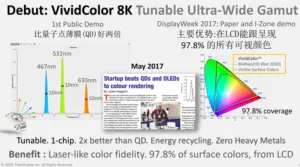![]() David Wyatt is from PixelDisplay, a company that we have reported on from SID last year and CES this year. He is an engineer from Nvidia and invented the company’s VividColor technology. Chris did a good job of describing the technology at CES, so have a look here (PixelDisplay Claims Advantages over QDs).
David Wyatt is from PixelDisplay, a company that we have reported on from SID last year and CES this year. He is an engineer from Nvidia and invented the company’s VividColor technology. Chris did a good job of describing the technology at CES, so have a look here (PixelDisplay Claims Advantages over QDs).
Wyatt started by highlighting the importance of portable devices and highlighted how much of the energy is going to the backlight. At the moment, HDR is taking a lot of power and needs more backlights – it’s a big challenge for all LCDs. However, Wyatt believes that consumers will pay more for a better display, especially if they can use the display all day.
Since SID last year, the company has introduced VividColor HDR which is more efficient than KSF phosphors and is faster. Temperature is a real challenge in LEDs and so is the use of different materials and technologies for RGB. It’s simpler to use a blue LED and colour convert than to create the different colours directly. PixelDisplay said its material is less temperature sensitive than QD or KSF.
The company has a new thin film stack to help develop better white LEDs. (and was demonstrating it – see below).
For front displays, the company’s technology can be tuned to match the display absorption and reflection of the display to optimise performance.
The company is going for a non-exclusive, open licence philosophy. Wyatt believes that QD will have challenges with the narrow bezel width that is required while achieving the brightness needed for HDR, while OLED has cost challenges.
The company is in a “C” series fund raising process and hopes to be cash flow positive in 2019. Most of the funds will be used to develop the supply chain, but the firm plans to stay fabless and simply develop technology. In some cases, it may offer free licences and make its money on material sales.
At the event, the company was showing an LED edge light array that used the firm’s materials integrated onto the LEDs. That means that it could be simply integrated into a monitor, notebook or TV very quickly.
(PixelDisplay won’t talk much about what they are doing but the word Strontium came up in some discussions that we overheard! Wyatt also said that it is more than simply a new kind of phosphor – he said that it is a new way of making white LEDs. On the one hand, we can understand why a small start-up might be paranoid about letting its secrets out, but on the other hand, when the company is so secretive and combines this we extravagant claims, it does set our sensors to alert! Ken wrote a DD that was sceptical last year, but the company did not respond to him, publicly or under NDA. PixelDisplay: Old Wine in a New Bottle)
![]() PixelDisplay showed this LED Bar which uses its phosphors. Image:Meko
PixelDisplay showed this LED Bar which uses its phosphors. Image:Meko
![]() PixelDisplay was showing the quality of its colour performance, but revealing few technical details, again. Image:Meko
PixelDisplay was showing the quality of its colour performance, but revealing few technical details, again. Image:Meko

